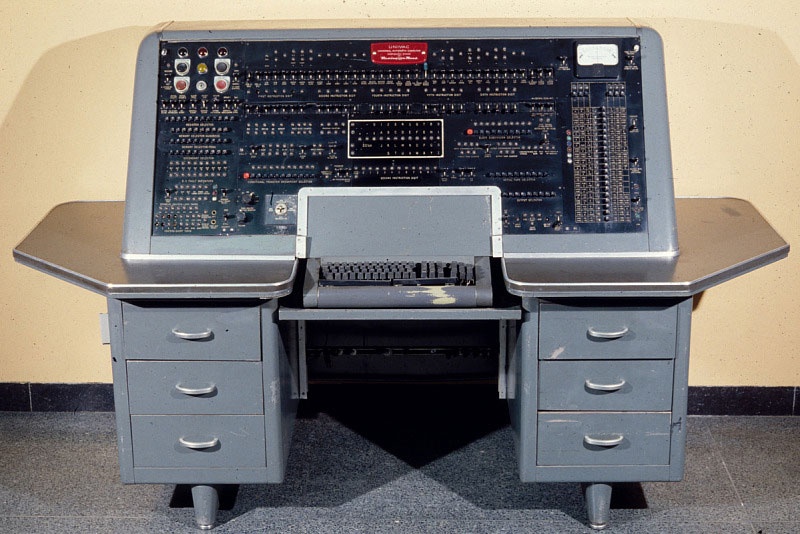A Little History
The internet has been connecting government entities since its official birthday was declared on January 1, 1983. Below is a model of an IT department using a UNIVAC (Universal Automatic Computer) that was delivered to the Bureau of the Census in 1951. It weighed some 16,000 pounds, used 5,000 vacuum tubes, and could perform about 1,000 calculations per second.[1] Forty-six (46) UNIVACs were installed, not only for federal agencies but also for the Commonwealth of Pennsylvania (see the mainframe component of UNIVAC I below). It was the first American commercial computer, as well as the first computer designed for business use.

Credit: National Museum of American History ID #1984.3073.01 Smithsonian Image 73-03061.

Credit: National Museum of American History ID #1984.3073.01 Smithsonian Image 73-03061. A UNIVAC I console.
Looking back, this was a completely new way of life, a digital era, sharing files through Transfer Control Protocol/Internetwork Protocol (TCP/IP). Imagine not having to use the Postal Service or delivery service to receive those monthly reports and proposals, not to mention the IT department’s physical space requirements.
The Transfer of Data
In 1989 the first commercial Internet Service Providers (ISPs) created “The World”. Because internet was only used for government purposes at the time, it was banned by the National Science Foundation (NSF) until 1991 when the ban was removed. In 1994 the NSF took control of the internet again. They commissioned four private companies to build access points located in San Francisco, Washington DC, Chicago, and New Jersey. These access points were controlled by WorldCom, Pacific Bell, Sprint, and Ameritech, the first real commercial ISPs.
Businesses as well as consumers were now able to connect their PC to the internet using a modem. For those who were not born yet, the sound of a modem is something you will never forget…a high pitch screeching sound like fingernails scratching down on a chalkboard. AOL Online, CompuServe, and Earthlink were the first gateways used with a modem to connect to the internet. The average monthly base cost was about $17.50 with an additional charge of $3 – $4 per hour for the time you were connected.[2] Remember, this was when computers were VERY slow and internet speed was approximately 10 kbit/s (we thought everything was fast back then!). It was not uncommon for monthly business internet bills to run in the thousands while sending/receiving data at the speed of a snail.



![]()
Present Day Internet
There is MUCH more history of the internet between 1994 -2022, but for this article, we will provide the Reader’s Digest version. In 2002, there were approximately 7,000 ISPs from which consumers and businesses could choose internet service. Some of these ISPs began replacing their copper networks with fiber optics. In 2017, through a plethora of consolidations, mergers, acquisitions, and bankruptcies, most parts of the country were controlled by a duopoly: Comcast and AT&T. Today, many governmental entities and businesses still only have one to as little as three ISPs that they can choose from including fixed wireless and satellite connectivity. For those in rural areas, many have Dedicated Internet Access (DIA) and hosted voice (VoIP) at speeds ranging from 10 MB to 100+ GB with pricing ridiculously low. Internet has become a commodity. Below is a timeline showing internet speeds from 1990 with average speed projections through 2050.

Global average Internet connection speed, 1990 to the present day (wired connections, excluding mobile, logarithmic scale), with a future predicted trend to 2050.
The AT&T Pains
For many businesses and governmental entities, working with a corporate giant such as AT&T can be very painful, emotionally speaking. It is difficult to get a representative on the phone to order or upgrade service, account managers change like the wind, and the installation process can be a nightmare if not followed and followed up on properly. Below is a basic process flow for ordering internet from AT&T.

The average timeframe from the quote to the first bill is approximately 60 days. If the process is not followed properly, a circuit order that’s halfway through the installation process can get canceled due to a lack of monitoring and follow-up. Many issues can occur during the order and installation process that can trigger early billing and stall the internet turn-up timeframe, for as long as one year or more!
The Solution
Many entities use internet Solution Providers (SPs) such as AmCom Solutions for multiple reasons:
- SPs are not resellers, so they provide governmental entities with AT&T pricing and no fee for their professional service as they are essentially an extension of AT&T’s sales.
- They have inside contacts to make the order and installation process as smooth as possible.
- Some SPs have access to (or know how to access) AT&T’s back office platforms, enabling them to generate contracts, submit orders, manage the provisioning process, and review the first bill for accuracy. Be sure the SP has AT&T back office capabilities and access to AT&T systems. Some SPs place the internet order, submits it to AT&T and leaves it up to the governmental agency to navigate through the mess. NOTE: AmCom is one of the few SPs that have full AT&T back office capabilities.
- After the internet service is complete, the governmental entity remains the customer of record with AT&T for all in-field technical support and future billing.
So why aren’t more governmental agencies and businesses using SPs to make their work life so much easier? There are a few reasons:
- There is a myth that Solution Providers “secretly” markup the internet pricing. This is far from the truth and as a matter of fact, it is incorrect. As a certified Solution Provider, AT&T prohibits the reselling (markup and/or private billing) of circuits unless the company is an official reseller. Using a reseller means that all invoices and service calls are billed and managed (post-installation) by the reseller. On the other hand, Solution Providers must provide AT&T pricing with no markups or fees.
- Many IT departments feel the need to fully manage the installation process themselves. They seldom know that there is an option that allows them to get crucial assistance for free and find themselves asking “what’s the catch?”. There is no catch. A proven Solution Provider just makes the IT job easier when it comes to ordering internet circuits. They are paid on commission, just like AT&T’s in-house sales executives except without the overhead.
- They believe that they should work directly with AT&T account managers with the notion that they will receive better support directly from AT&T. This is no longer the case as AT&T has downsized and restructured, resulting in continuous turnover and no long-term relationships.
An example of working with a Solution Provider, specifically AmCom Solutions, is the City of Seguin, TX. The City received ARPA grant funding for a telecom infrastructure refresh and e-911, a mandated requirement. The City was set to move away from its legacy AT&T circuits due to many years of unsatisfactory support, countless account representative changes, and horrendous communication from a business partner (AT&T) providing a critical service. Due to those frustrations, they were 100% prepared to move the City to SIP trunks just to avoid continuing business with AT&T. AmCom had just joined TAGITM and was introduced to the City. After learning about AmCom’s AT&T experience and dedication, the City decided to give AT&T another chance by using a Solution Provider.
“Trust is a big thing in my world. I do not have the time or patience to deal with corporate incompetence. AT&T has completely failed to deliver for my organization and seemingly many of my peers in local government. I did an AT&T audit in my previous role, and here in Seguin. Both of them added up to $20k+ in savings annually in perpetuity because of the failures in terminating unneeded assets. Failed disconnects and the subsequent billing errors add up,” said Shane McDaniel, Director – IT, City of Seguin, TX. “Good luck getting your AT&T account rep to do the right thing and help lead you through the process of sorting out issues. The process was made so much easier by using a Solution Provider and returning some semblance of faith in AT&T. Thanks to AmCom, and only because of the relationships established with our new business partner, did we extend our dealings with AT&T. I am personally thankful to have crossed paths with AmCom…it’s been a good partnership and I’m a fan of the service they provide. I cannot thank the AmCom team enough for what they do.”
———————–
Scott Fairbairn is the Founder and President of AmCom Solutions, headquartered in Austin, TX. The company has been an AT&T Solution Provider since 2006. Scott has over 30 years of leading and managing outside sales and channel development. He is a graduate of Auburn University with a B.S. degree in Criminal Justice and Law Enforcement with minors in Sociology and Political Science. He’s also a graduate of the FBI Citizens Academy and served as President of the FBI’s Capital of Texas InfraGard chapter.
Shane “El Jefe” McDaniel is the Director of IT for the City of Seguin with 27 years of experience across numerous IT disciplines. His technology career began in 1996 through an enlistment in the Air Force supporting military intelligence and reconnaissance. Mr. McDaniel is a published author with a B.S. and M.S. in Information Technology and holds CGCIO, PMP, CISM, ITIL, and CompTIA certifications.
—————————————-
[1] University System of Georgia
[2] secjuice: “A Short History Of Internet Access & Internet Service Providers (ISP’s)”, December 9, 2018



